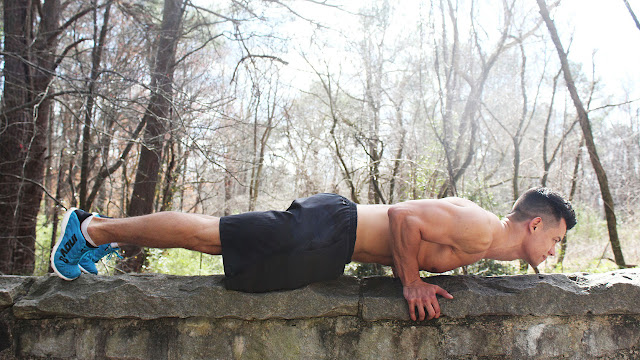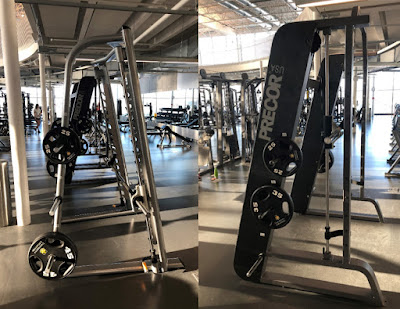Bodyweight Training for Size and Strength
by Adam Toffan, M.Sc, NSCA-CSCS, CSEP-CEP Assistant Fitness Training and Assessment Coordinator, Recreation Services at the University of Manitoba
Even with gyms opening again, many people continue to exercise at home, whether to feel safer or because gyms are at a lower capacity. One of the most significant issues people are having without gym access is maintaining their strength training without the equipment. Maintaining high levels of muscle strength and hypertrophy is important to a variety of populations. For the general public, muscular strength facilitates daily living activities. It has wide-ranging implications for health and wellness, including evidence of a clear inverse relationship between muscular fitness and mortality. Traditionally, loads greater than 65% of the max weight you can lift one time (1 repetition maximum or 1RM) for muscle growth (hypertrophy) and even higher loads to maximize strength.
This week I want to cover the effects and implementation of bodyweight and low load resistance training.
In recent years some investigators have challenged the view that heavy loads are required to induce muscular adaptations and claim that recruitment of the full spectrum of motor units is achievable with low-load training if repetitions are performed to muscular failure. There is evidence to suggest fatiguing low load or bodyweight exercises may reduce the threshold for recruitment of high-threshold motor units. This reduction in threshold means an increased proportion of motor units may be activated as the point of muscular failure is reached. Now that we know failure is the key, how do we get there with bodyweight or low-load resistance training?
Prolong eccentric phase
Depending on your base level of strength, traditional bodyweight exercises may be difficult enough to reach the previously mentioned recommendations. If that is the case, you can execute bodyweight exercises with the same set/rep scheme you use with equipment. If you have enough strength, some bodyweight exercises done in a standard fashion will not be challenging enough to reach fatigue in a reasonable time. One way to ensure your bodyweight exercises get you to muscular failure is to prolong the movement's eccentric phase. The eccentric phase is the part of the activity where the muscles are lengthening under tension. Often, this is the "lowering" phase of the exercise (i.e. squat). Several studies have indicated that a slower tempo of movement, especially during the eccentric phase, decreases the number of performed repetitions but extends the time under tension, contributing to greater muscle hypertrophy. Greater hypertrophy allows you to reach fatigue without adding reps to your workout.
Accentuated eccentric loading
A spin from the tempo eccentric method is accentuated eccentric loading, although it is a step away from bodyweight training. This strategy is based on the muscles' ability to generate greater force during maximal eccentric contractions than other contraction types (isometric, concentric). The addition of resistance for the exercise's eccentric component will further emphasize the eccentric phase to increase fatigue. You can unload the weight in the transition from the eccentric to the concentric phase of the movement. However, this method may require a partner to apply additional load to the movement.
Manipulating rest periods
Another technique that enhances metabolic stress is manipulating rest periods. Reducing the rest interval limits recovery and accelerates the accumulation of fatigue. Shortening rest periods will make sets progressively harder, eventually leading to the desired muscular failure allowing you to reach fatigue without additional reps or time. Either of the strategies above, alone or in combination, should increase time under tension or difficulty of bodyweight exercises leading to greater fatigue and high threshold motor unit recruitment.
You can implement several strategies to make bodyweight training an adequate stimulus if building muscle is your goal. However, if maximal strength is your training goal, these strategies are not as effective. If strength is your goal, you will likely need additional resistance from machines or free weights. Also, more experienced exercisers may find it more difficult to see improvements with bodyweight or low-load training. A "ceiling effect" makes it progressively difficult for trained individuals to increase muscular gains over time, thereby necessitating progressive resistance training protocols to elicit continual hypertrophic and strength responses.
If you continue to exercise at home and are looking to continue to build, try some of these strategies to make your bodyweight workouts get you to muscular failure. Get creative and good luck!
Sources
Schoenfeld, B.J.; Peterson, M.D.; Ogborn, D.; Contreras, B.; Sonmez, G.T. (2015). “Effects of Low- vs. High-Load Resistance Training on Muscle Strength and Hypertrophy in Well-Trained Men.” Journal of Strength and Conditioning Research. Volume 29(10). Pp. 2954-2963.
Schoenfeld, B.J., et al. (2019). “Resistance Training Volume Enhances MuscleHypertrophy but Not Strength in Trained Men.” Medicine & Science In Sports & Exercise. Vol. 51(1). Pp. 94–103.
Krzystofik, M.; Wilk, M.; Wojdala, G.; Golas, A. (2019). “Maximizing Muscle Hypertrophy: A Systematic Review of Advanced Resistance Training Techniques and Methods.” International Journal of Environmental Research Public Health. Vol. 16(24). Pp. 4897-4912.




I read your article and it’s informative.
ReplyDeleteI always share your blog post links on my
social media platforms and in different groups.
I am also writing some related articles.
I really like your blog, keep it up!
Nice post thank you for sharing.
https://iwillhavethat.com/how-to-choose-your-right-skis/
Finally, I am getting some valuable information about bodyweight training for size & strength. You explained everything here so perfectly. Thank you for sharing a nice post. Above that, if you are looking for a rehab center in Henderson then must visit Aguirre Fitness. Highly skilled, experienced & professional teams, help people to get rid of any drug addiction and other substances.
ReplyDeleteMaik Wiedenbach : fitness coaches deliver individualized fitness programs to help you achieve your goals.
ReplyDelete